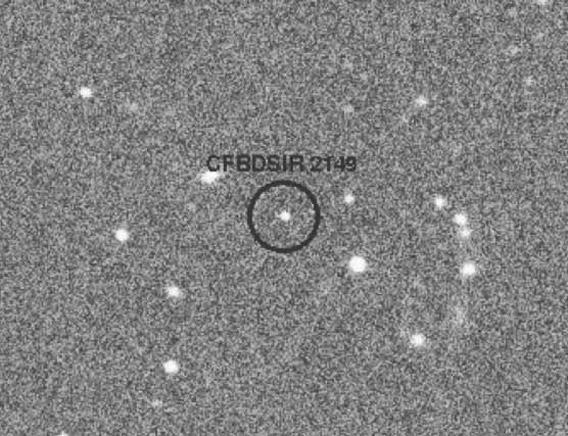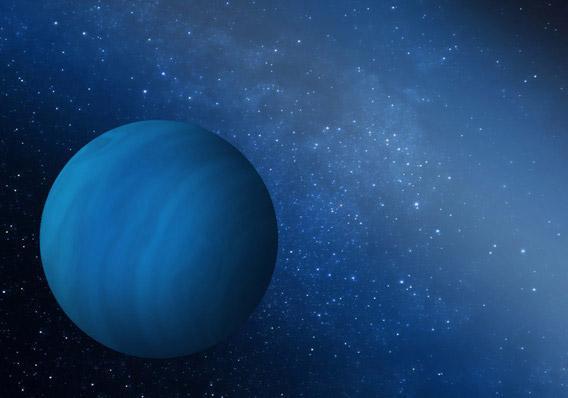When you think of an example of a planet, you probably picture something like Earth. A round object, mostly solid, maybe with a thick atmosphere (though that’s optional). Right? And one thing you’d probably do is imagine it orbiting a star. After all, every planet we’ve seen so far—including those in our own solar system, of course—circles a star. Right?
Except not so much. Nature is way more clever than we are. It finds methods to make planets that stretch our imagination and put the very word “planet” to the test.
Meet CFBDSIR2149, what looks very much like a rogue planet—one that doesn’t orbit a star—and may be the closest example of one ever seen.
It doesn’t look like much, I’ll admit, but don’t let the appearance fool you. It’s a weirdo—and may be one of the more important objects planetary scientists have found yet.

Image Credit: CFHT/P. Delorme
It was discovered by astronomers surveying a small clot of stars located just about 75 light years from Earth surveying the sky looking for extremely faint stars, and is located about 120 light years away near a small clot of stars. This cluster, called AB Doradus, is a group of about 30 stars that probably formed together and are still moving through space together, like a swarm of bugs. Using various measurements of the stars themselves, astronomers have determined the stars are young: less than 200 million years old for sure, and possibly only a tenth that age. That may sound ancient, but compare that to the Sun’s age of 4.6 billion years and you see the AB Dor stars are actually pretty sprightly.
The astronomers probed the cluster using a telescope sensitive to infrared light. They were specifically looking for objects of low mass, which, at the cluster’s age, tend to glow brightly at those wavelengths, still warm from their recent formation. What they found was CFBDSIR2149.
If it is indeed a member of the cluster, then it’s almost certainly a planet-like object. It would have a mass about four to seven times that of Jupiter: Earth-like, it ain’t. It’s big, but well below the mass a star would have, and still fairly safely in the range of what we call a planet. It has a temperature of about 450 degrees Celsius (850 degrees Fahrenheit), which is pretty warm by human standards, but even the smallest, coolest stars are hotter. Again, it looks more like a planet than a star.
But the most interesting bit is that there’s no star nearby! That is, it doesn’t appear to be orbiting a star; it’s sitting out there in the cluster, but pretty much on its own. That’s one of the reasons the astronomers could study it so well. With no close star, the object’s light was easy to see and analyze. A nearby star would’ve washed it out.
So it appears that CFBDSIR2149 is actually a rogue planet, an isolated world traveling through space. That’s wonderful!
To be clear, it’s not 100 percent certain that’s what’s going on. There’s a small chance it’s not part of the AB Doradus cluster, and is actually a background star located much farther away but only appears to be sitting in the cluster (like a much more distant house coincidentally seen between two of your neighbor’s houses across the street). But the likelihood of that is small; the astronomers themselves give that less than a 15 percent chance; or, if you prefer, there’s an 85 percent chance it really is a cluster member.
I read their research paper, and my own feeling is that the object really is a cluster member. Why? Because they show the spectrum of the object and it fits that of a young, hot planet. A spectrum is the light from an object broken up into colors, like a rainbow is white light broken up into seven colors. But when astronomers take an object’s spectrum, they break the light up into thousands of separate, narrow colors. Using this spectrum, an amazing amount of information can be determined, including the object’s temperature, chemical composition, velocity through space, and even whether it’s rotating or not. In this case, to my eye, CFBDSIR2149 looks very much like a planet. I could be wrong, of course, but it’s the way to bet.
Mind you, it’s not the first such rogue planet seen. There are several ways to find them, and quite a few have been found. But most are very far away, making them hard to study. CFBDSIR2149 is close by—120 light years puts it among the closest objects in our galaxy to the Earth—so we can get detailed observations of it. In fact, it’s so well-observed it may become a standard against which other such objects are judged.
I find this whole thing amazing. It wasn’t that long ago that the only planets we knew of orbited the Sun. The first exoplanets—planets orbiting other stars—were found in the early 1990s, and now we know of hundreds of them! And they come in a variety of sizes and temperatures and orbit all manners of stars, from dinky, cool, red dwarfs to multiple star systems that seem like something you’d see in a sci-fi movie. And now here’s one close by that doesn’t even have a star to call its own. It’s incredible.
This is one of the reasons I love astronomy. It’s the surprises! The more we try to understand what’s going on, the more weird stuff we find. The sheer diversity and strangeness of the Universe is one of the reasons it’s so wonderful, and why studying it will never, ever get old.
